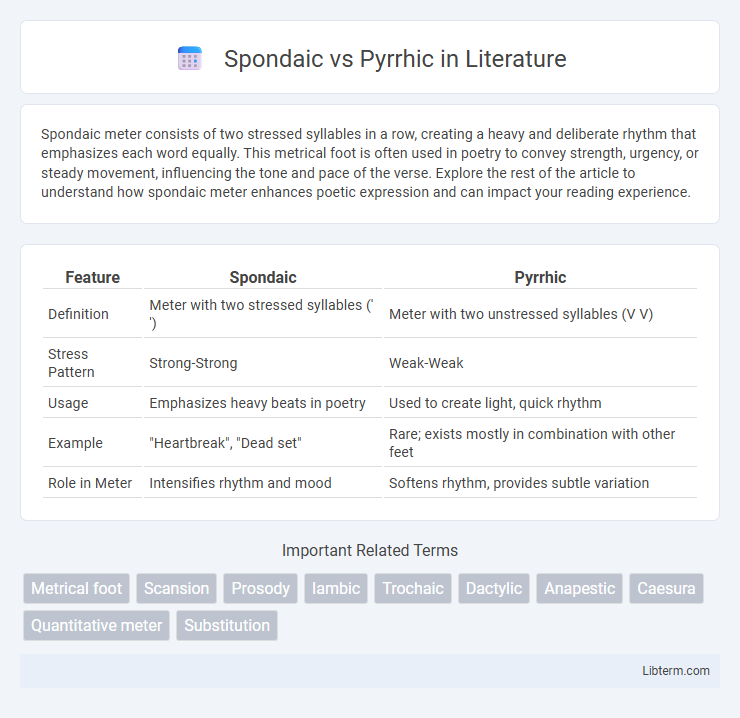Spondaic meter consists of two stressed syllables in a row, creating a heavy and deliberate rhythm that emphasizes each word equally. This metrical foot is often used in poetry to convey strength, urgency, or steady movement, influencing the tone and pace of the verse. Explore the rest of the article to understand how spondaic meter enhances poetic expression and can impact your reading experience.
Table of Comparison
| Feature | Spondaic | Pyrrhic |
|---|---|---|
| Definition | Meter with two stressed syllables (' ') | Meter with two unstressed syllables (V V) |
| Stress Pattern | Strong-Strong | Weak-Weak |
| Usage | Emphasizes heavy beats in poetry | Used to create light, quick rhythm |
| Example | "Heartbreak", "Dead set" | Rare; exists mostly in combination with other feet |
| Role in Meter | Intensifies rhythm and mood | Softens rhythm, provides subtle variation |
Introduction to Spondaic and Pyrrhic Meters
Spondaic meter consists of two consecutive stressed syllables creating a deliberate and heavy rhythm, often used to emphasize urgency or gravity in poetry. Pyrrhic meter features two unstressed syllables in a row, producing a lighter and quicker pace that contrasts with more accented feet. Both meters serve specific rhythmic functions, enriching the texture and emotional impact of verse in classical and modern poetry.
Defining Spondaic Meter
Spondaic meter consists of a metrical foot with two equally stressed syllables, creating a slow, deliberate rhythm often found in classical poetry to emphasize particular words. This contrasts with the pyrrhic foot, which comprises two unstressed syllables and is less common in English verse due to its subtle rhythm. Understanding spondaic meter is essential for analyzing poetic emphasis and pacing in works ranging from Homeric epics to modern poetry.
Understanding the Pyrrhic Foot
The pyrrhic foot in poetry consists of two unstressed syllables, contrasting with the spondaic foot, which contains two stressed syllables, making the pyrrhic rare and subtle in English verse. Understanding the pyrrhic foot involves recognizing its role in creating rhythmic variation and emphasizing the fluidity of natural speech patterns within iambic or trochaic meters. Mastery of the pyrrhic foot enhances the analysis of metrical tension and the nuanced pacing in classical and modern poetry.
Historical Origins and Usage
Spondaic and pyrrhic meters originate from ancient Greek and Latin poetry, where they served distinct rhythmic roles in classical verse. The spondaic meter, consisting of two long syllables, emphasized solemnity and weight, often used to slow the pace and add emphasis in epic and tragic poetry. Pyrrhic meter, composed of two short syllables, was less common and functioned primarily as a connective element within longer metrical patterns to maintain rhythm and fluidity.
Spondaic vs Pyrrhic: Key Differences
Spondaic and pyrrhic meters differ primarily in syllabic stress patterns; a spondaic foot consists of two equally stressed syllables (e.g., "heartbreak"), while a pyrrhic foot contains two unstressed syllables (e.g., "in a"). Spondaic meter is often used to create emphasis and slow rhythm, contrasting with the light, swift movement of the pyrrhic meter. In English poetry, spondaic feet are relatively rare and used for dramatic effect, whereas pyrrhic feet are less commonly identified but contribute to metrical variation within lines.
Examples of Spondaic in Poetry
Spondaic meter consists of two stressed syllables in a row, creating a slow and heavy rhythm often used to emphasize particular words or themes in poetry. Examples of spondaic feet can be found in classical works like Homer's *Iliad*, where phrases such as "dead march" and "heartbreak" provide a solemn and weighty effect. Modern poets might also use spondaic patterns in lines like "Long days, cold nights" to evoke a strong emotional tone or rhythmic impact.
Examples of Pyrrhic in Poetry
Pyrrhic meter consists of two consecutive unstressed syllables and is rare in English poetry due to the language's natural stress patterns. Examples of pyrrhic feet appear subtly within famous poems, such as in Tennyson's "The Charge of the Light Brigade," where phrases like "in the" create a pyrrhic rhythm amid more varied metrical feet. Poets often use pyrrhic feet to create a softer, flowing effect that contrasts with the heavier, equally stressed spondaic feet found in lines like "Break, break, break" by Tennyson.
Effects on Rhythm and Sound
Spondaic meter, characterized by two stressed syllables, creates a heavy, forceful rhythm that emphasizes solemnity or urgency in poetry, while pyrrhic meter, with two unstressed syllables, produces a light, fleeting sound that can subtly shift the poem's pace. The stark contrast between the spondaic's weighty cadence and the pyrrhic's softness influences the overall sonic texture, enhancing emotional intensity or providing a momentary relaxation in the verse. Poets employ spondaic and pyrrhic feet strategically to manipulate rhythm and sound, thereby deepening the auditory experience and reinforcing thematic elements.
Role in Classical and Modern Literature
Spondaic and pyrrhic meters play distinct roles in classical and modern literature, shaping rhythm and emotional intensity. Spondaic meter, composed of two stressed syllables, often emphasizes solemnity or gravity in classical epics and modern poetry. Pyrrhic meter, with two unstressed syllables, introduces subtlety and fluidity, creating contrast and nuanced pacing across literary traditions.
Conclusion: Significance in Prosody
Spondaic and pyrrhic feet play critical roles in prosody by providing rhythmical contrast that enhances a poem's metrical complexity and emotional impact. Spondaic feet, with their two stressed syllables, create emphasis and weight, while pyrrhic feet, consisting of two unstressed syllables, introduce subtle pauses and lightness. Understanding the interplay between these metrical feet deepens the analysis of poetic rhythm and contributes to a richer interpretation of verse.
Spondaic Infographic

 libterm.com
libterm.com